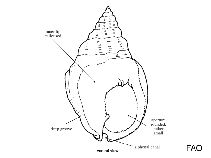Nassarius gibbosulus (Linnaeus, 1758)
Upload your photos
Google image | No image available for this species;
drawing shows typical species in Nassariidae.
Google image | No image available for this species;
drawing shows typical species in Nassariidae.
Classification / Names Common names | Synonyms | CoL | ITIS | WoRMS
Gastropoda | Neogastropoda | Nassariidae
Environment: milieu / climate zone / depth range / distribution range Ecology
Benthic. Subtropical
Distribution Countries | FAO areas | Ecosystems | Occurrences | Introductions
Mediterranean Sea.
Length at first maturity / Size / Weight / Age
Maturity: Lm ? range ? - ? cmCommon length : 1.3 cm SHL male/unsexed; (Ref. 360)
Short description Morphology
Shell: quite thick and strong, a rather high conical spire, short siphonal canal, open and twisted; body whorl is very large, spherical, covering much of the preceding one, involute, suture is hardly incised; aperture is ovoidal, outer lip has an external thickening and thin internal folds; in adults, columellar lip forms a large callus that completely covers the ventral surfaces of the body whorl; no sculpture except for a rib with one, two of three hardly visible blunt nodules, on the periphery of the dorsal surface of the body whorl; color is yellowish or yellow brown, callus and lips are white; operculum is horny, yellowish, has an apical nucleus, roughly triangular, fringed inner and outer margins. Body: wide triangular foot, many nassariids, two appendices at the posterior end; very long mantle siphon; radula is rachiglossan.
Life cycle and mating behavior Maturity | Reproduction | Spawning | Eggs | Fecundity | Larvae
This species is a non-broadcast spawner. Life cycle does not include trocophore stage. Also Ref. 833.
Main reference
References | Coordinator | Collaborators
Templado, J. and R. Villanueva. 2010. (Ref. 85339)
IUCN Red List Status (Ref. 130435)
CITES status (Ref. 108899)
Not Evaluated
CMS (Ref. 116361)
Not Evaluated
Threat to humans
Harmless
Human uses
| FishSource |
Tools
More information
Internet sources
BHL | BOLD Systems | CISTI | DiscoverLife | FAO(Publication : search) | Fishipedia | GenBank (genome, nucleotide) | GloBI | Gomexsi | Google Books | Google Scholar | Google | PubMed | Tree of Life | Wikipedia (Go, Search) | Zoological Record



